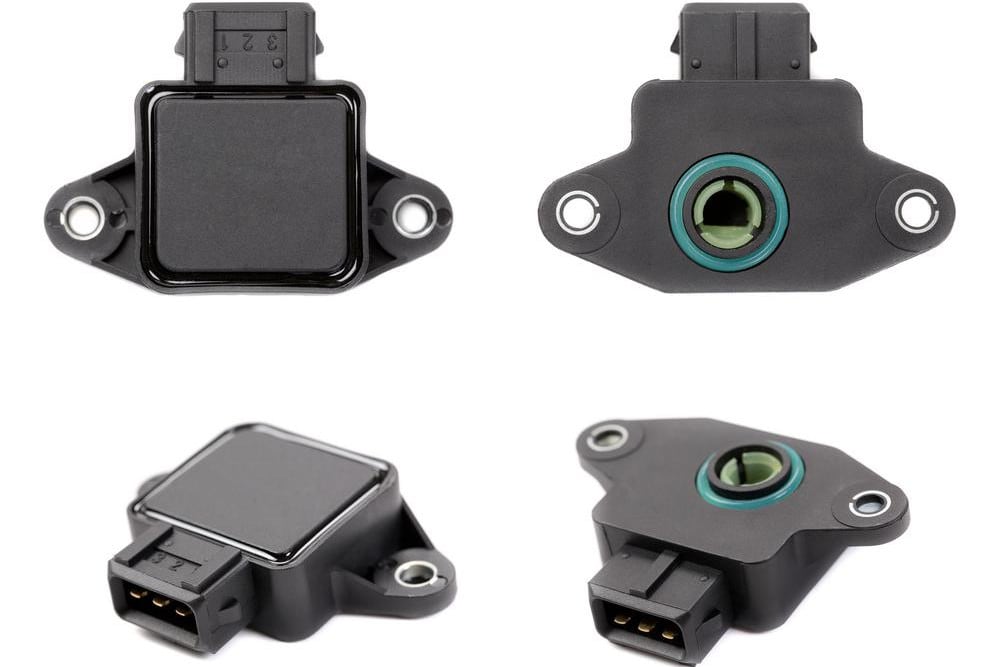

The throttle position sensor (TPS), is part of your vehicle's fuel management system and helps ensure that the correct mixture of air and fuel is delivered to your engine. Note that the throttle body position sensor is different from the throttle body temperature sensor. The TPS provides the most direct signal to the fuel injection system of what power demands are being made by the engine. The TPS signal is continually measured and combined many times per second with other data such as air temperature, engine RPM, air mass flow, and how quickly the throttle position changes. The collected data determines precisely how much fuel to inject into the engine at any given moment. If the throttle position sensor and its other sensor partners do their jobs correctly, your car accelerates, cruises, or coasts smoothly and efficiently, as you expect, while maintaining optimum fuel economy.
The throttle position sensor can fail in several ways, all of which result in poor fuel economy at best, and performance limitations that may create a safety hazard for you and other motorists at worst. It can also cause problems when changing gears, or setting base ignition timing. This sensor can fail gradually, or all at once. In most cases, the Check Engine Light is illuminated if a faulty TPS is detected. Also, most manufacturers provide a “limp home” mode of operation with reduced power if a failure is detected. This is intended to at least allow a driver to get off a busy highway in a safer manner.
A throttle position sensor lifespan varies between different vehicles and a lot of factors can go into why it might go bad.
Once the TPS starts to go bad, even partially, you’ll need to replace it right away. Replacing the TPS will include clearing relevant fault codes, and may require software reprogramming of the new TPS module to match other engine management software. This is all best left to a professional mechanic who can provide you with a diagnosis, and then install the correct replacement part.
Bad Throttle Position Sensor Symptoms
1. Engine Won’t Idle Smoothly, Idles Too Slowly, or Stalls
If you start to experience engine misfires, stalling, or rough idling when the car is stopped, it can also be a warning sign of a bad TPS. If it is a faulty throttle position sensor, you definitely don't want to wait to get this checked out.
If the idling appears off, it means the computer is unable to identify the fully shut throttle. A faulty TPS can also send bad input that ends up stalling the engine at any time.
2. Car Accelerates, But Won’t Exceed Low Speed or Shift Up
When your throttle position sensor is failing, it can lead to a limitation on the power your car can deliver in response to your accelerator pedal input.
In this scenario, as you press the accelerator, the TPS sends inaccurate signals to the engine control unit (ECU), falsely indicating a need for reduced power. This miscommunication between the TPS and the ECU leads to a restricted acceleration, often capping the speed at 20-30 MPH.
This issue is closely associated with an overall loss of power, where the vehicle struggles to achieve its normal performance levels. The TPS is responsible for gauging throttle position and relaying this information to the ECU and plays a crucial role in determining the appropriate fuel and air mixture for combustion. When it malfunctions, the ECU receives incorrect data, resulting in a faulty power response, leading to a low acceleration capacity.
3. Check Engine Light Comes on With Any Other Bad TPS Symptoms
The Check Engine Light may come on if you’re dealing with a bad throttle position sensor. This isn’t always the case though, so don’t wait for the Check Engine Light to illuminate before you get any of the above symptoms checked out. Have your vehicle checked for trouble codes to verify the source of the problem.
The throttle position sensor is key to getting the desired power and fuel efficiency from your vehicle in any driving situation. As the symptoms listed above make clear, failure of this component has serious safety implications and must be checked out immediately by a qualified mechanic.



